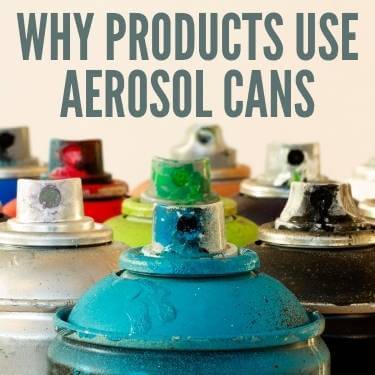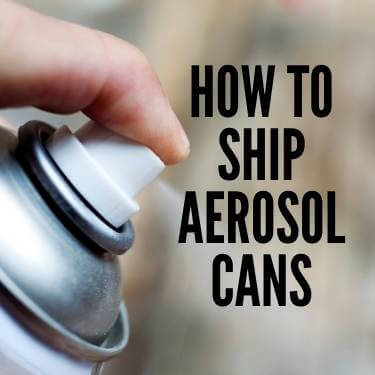personal beauty, home improvement, food or other uses, it is inescapable. Yet due to the potential volatility because of the nature of these products, it’s understandable that a business needing these items shipped for the first time might be at a complete loss where to start.
However, as long as your products are properly labeled and packed while some basic rules are followed, there should be nothing to worry about when freight shipping aerosol cans. While the cans can contain ingredients that can be hazardous or flammable, careful preparation will go a long way toward being successful.

From hair spray to shaving cream, or insect sprays to bathroom cleaners, there are a variety of items that utilize aerosol (short for aero-solution) cans to dispense the contents within. The liquid inside an aerosol spray can is propelled through a tiny hole and comes out as a very fine mist that usually dissipates very quickly.
The propellants used to force the liquid out could be something as simple as compressed gas but commonly are flammable hydrocarbons such as isobutane, propane and n-butane. As far as food products go, carbon dioxide and nitrous oxide is often used as the propellant in cooking sprays and whipped cream.
While some of the liquid coming out of an aerosol can will still leave behind actual liquid, the reason this is used is the mist or aerosol expelled from the can hangs in the air and doesn’t settle on surfaces as a wet mess. An example of this is spraying an air freshener in your home. If you spray it around in the air, it will do its job without leaving your furniture or floors slick with wetness since the aerosol will soon dissipate. The same goes with a bug spray.
With the versatility and unique technology, aerosol cans have a place in households around the world and aren’t going anywhere. So the next step in the equation is knowing the best way to handle them during shipping so that they reach consumers in excellent, safe shape.

Every aerosol can produced is found under Class 2 on the hazardous materials table as a gas. This means there are very specific instructions for both labeling and shipping these items since they can be subject to dangerous leakage — leading to contamination or fumes that are highly flammable — and even explode if placed under undue pressure.
Learn more about DOT Hazmat Classes.
Aerosol containers are surface transportation-only, meaning they’re not eligible to be shipped via aircraft. To ship dangerous goods, you can use truck, ocean freight or rail but still have to take certain precautions in order to safely have your goods transported. This starts by appropriately labeling your cargo as Class 2, whether it’s on the outer box they are packaged in or the shipping container itself. Any labeling should denote what hazardous chemicals, gases or waste are in or can occur as a result of using the product.
The cans themselves need to be in proper working order before they ship since the threat of flammable gases or someone loading or unloading the products could have their skin come in contact with certain dangerous liquids.
This can be anything, even “canned air” used to clean out electronics or to dust. It’s not actually air coming out of the aerosol can but a compressed gas that is harmful to your health, possibly to the point of causing death.
When shipping aerosol cans, a few precautions related to temperature and humidity need to be minded. For instance, once the temperature approaches 120 degrees fahrenheit for an aerosol can, the item is at great risk to explode. Also, aerosol cans should be kept in dry conditions that are free of moisture and humidity as well.
As far as the shipping, there are a few things to understand. You’ll need to choose a company that is an official hazmat carrier since not just any trucker can transport this possibly dangerous freight. Also, it’s a great idea to purchase specialized insurance that is tailored to cover hazardous materials. If you request it, your freight quote from a third-party logistics (3PL) company can include hundreds of thousands of dollars in coverage to insure a variety of different outcomes involving your aerosol cans. These will protect both your products and general liability, for instance.
Need help with freight shipping from Connecticut to Florida? See how the right freight ally can help.
Now that you’re well versed in the intricacies that surround truckload freight shipping aerosol cans, it’s time to seriously think about having R+L Global Logistics handle the transportation of them for you. With our sterling reputation in the third-party logistics and freight broker world and a commitment to safety in handling hazmat materials, it’s a smart bet to partner with us to move these fragile goods.
R+L Global Logistics has experienced hazmat carriers and other employees who are well-versed in working with hazardous products and will take great care with your valuable cargo to ensure it reaches its destination in its original, safe condition. Not only do we care about the state your aerosol cans arrive at their end point, but our company prides itself on getting the load there on time. In fact, we boast a 99.5 percent on-time delivery rate that is sure to help put your mind at ease.
With our care and on-time deliveries, R+L Global Logistics offers a few other standard amenities with all of our freight shipments. The first is real-time visibility for all transport booked through our company. We pair that with our industry-leading customer service that is available at all times and can address any questions or concerns you have.
So when you’re prepared to start freight shipping aerosol cans, make the informed choice to book the transportation through R+L Global Logistics. You can call us at 866.353.7178 for a truckload freight quote today.
R+L Global Logistics
315 NE 14th St., Ocala, FL 34470